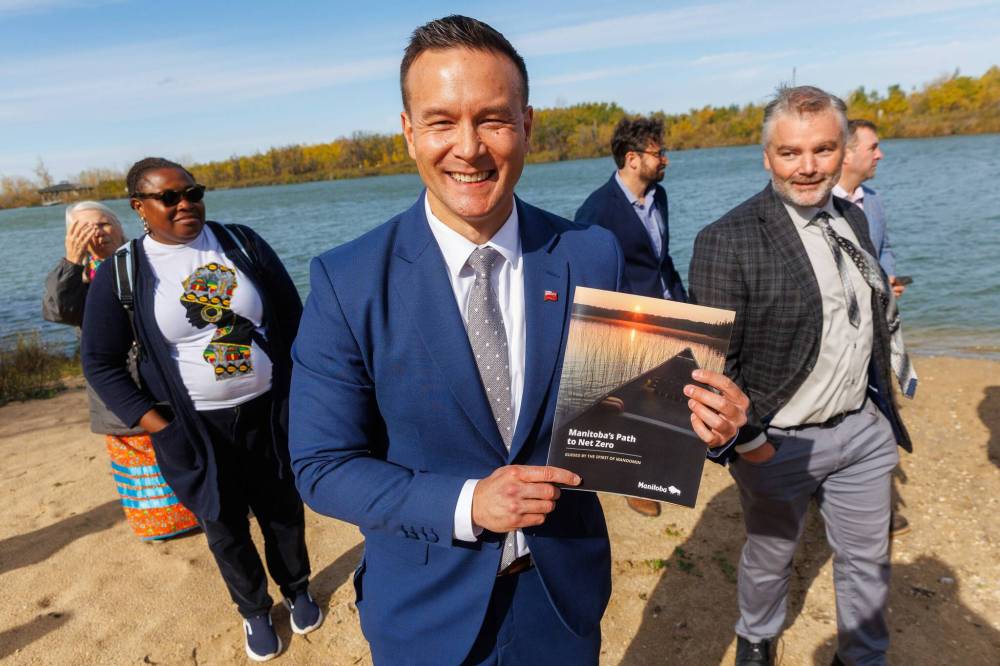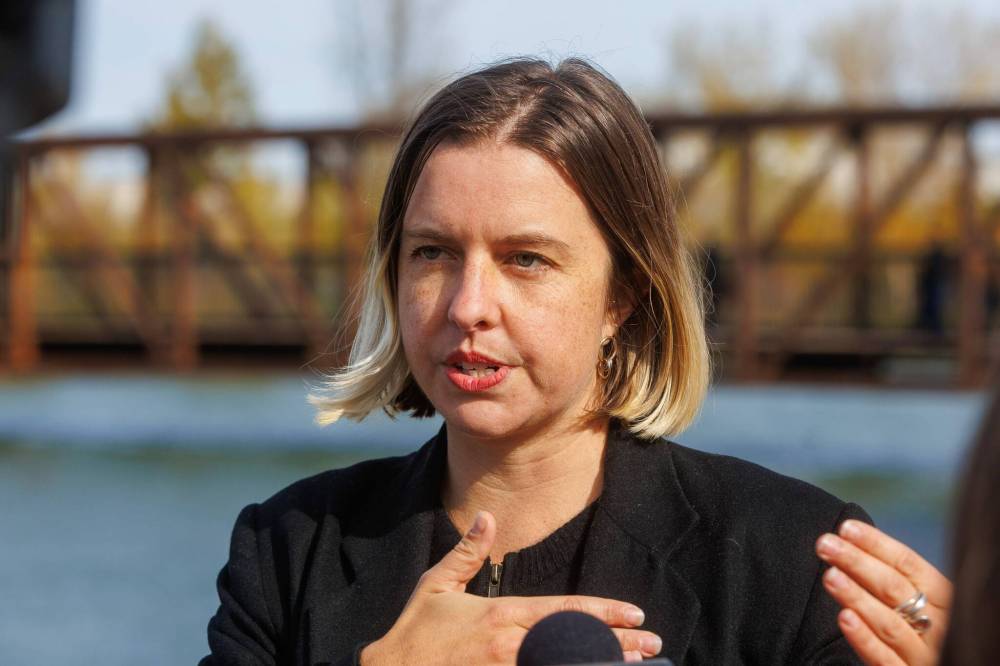Province unveils long-term blueprint to achieve net-zero emissions
Advertisement
Read this article for free:
or
Already have an account? Log in here »
To continue reading, please subscribe:
Monthly Digital Subscription
$0 for the first 4 weeks*
- Enjoy unlimited reading on winnipegfreepress.com
- Read the E-Edition, our digital replica newspaper
- Access News Break, our award-winning app
- Play interactive puzzles
*No charge for 4 weeks then price increases to the regular rate of $19.00 plus GST every four weeks. Offer available to new and qualified returning subscribers only. Cancel any time.
Monthly Digital Subscription
$4.75/week*
- Enjoy unlimited reading on winnipegfreepress.com
- Read the E-Edition, our digital replica newspaper
- Access News Break, our award-winning app
- Play interactive puzzles
*Billed as $19 plus GST every four weeks. Cancel any time.
To continue reading, please subscribe:
Add Free Press access to your Brandon Sun subscription for only an additional
$1 for the first 4 weeks*
*Your next subscription payment will increase by $1.00 and you will be charged $16.99 plus GST for four weeks. After four weeks, your payment will increase to $23.99 plus GST every four weeks.
Read unlimited articles for free today:
or
Already have an account? Log in here »
The Manitoba government has released its “ambitious” roadmap to reach net-zero emissions by 2050 while building a more climate-resilient economy.
Premier Wab Kinew and Environment and Climate Change Minister Mike Moyes unveiled the 32-page plan to transition away from carbon-intensive energy sources and invest in renewable fuels at Fort Whyte Alive Monday, drawing both plaudits and criticism from climate-action groups who hoped to see detailed action plans accompany the province’s far-reaching goals.
“Manitoba has always been a province that builds things, grows things, powers things, and we can do it while cutting emissions and keeping our economy strong,” Moyes said.

MIKE DEAL / FREE PRESS
Environment and Climate Change Minister Mike Moyes, along with Premier Wab Kinew, unveil Manitoba’s Path to Net Zero during an event at Fort Whyte Alive Monday.
“The move to net zero means we can reduce our reliance on imported fossil fuels and instead use more Manitoba-made renewable energy, keeping jobs and dollars right here in Manitoba.”
The strategy was developed in consultation with experts, businesses, Indigenous communities and municipalities and includes more than 40 initiatives that “touch on every part of the economy and everyday life,” he said, starting with a climate change committee of cabinet that will incorporate the net-zero plan into all governmental decisions.
Moyes said the province will work to address its own in-house pollution by updating the green building policy, which sets sustainability criteria for all new government-funded buildings, transitioning provincial fleets to zero-emission vehicles and strengthening legislation to hold government accountable to its climate targets.
It will also encourage Manitoba Hydro to work towards a net-zero electricity grid by 2035 and support Northern and remote communities to transition away from diesel-powered electricity.
To address emissions in the province’s most polluting sectors, the plan commits to investing in Efficiency Manitoba, promoting the development of district energy systems, supporting research and innovation into regenerative agriculture, expanding public and active transit networks in rural communities and developing a network of publicly owned electric vehicle chargers.
Michelle Bergen, president of the union representing Hydro employees, praised the government’s plan to invest in public energy infrastructure in a statement Monday.
“With Manitoba Hydro at the helm, we are positioning ourselves to be a leader in clean energy in transportation, job creation in the energy sector, while also reducing costs for Manitobans,” Bergen said.
Alongside its low-carbon fuel initiatives, the province aims to offset emissions by protecting forests, wetlands, peatlands and other natural carbon sinks. Manitoba will work with the federal government to study the feasibility of a marine conservation area in western Hudson Bay, which Kinew described as a way to offset the impacts of proposed development at the Port of Churchill.
“We are talking about a mega-project in northern Manitoba whose terminus could be the port of Churchill. As a result, let’s protect a huge area of the waters just to the west of that,” the premier said.
“This is the fundamental idea behind this plan… everything we do is going to have an impact, so along with planning the economic project, let’s also plan for the environmental offset.”
Ron Thiessen, who heads the Manitoba chapter of the Canadian Parks and Wilderness Society, applauded the province’s commitment to conservation targets such as the 30 by ’30 initiative — which aims to protect 30 per cent of lands and waters by 2030 — and its work on a potential marine conservation area in Hudson Bay.

MIKE DEAL / FREE PRESS
Laura Cameron, director of the Manitoba Climate Action Team, speaks to journalists after Monday’s news conference.
“With the enhancement of the port and shipping increases, we need to ensure that we also protect the belugas, the polar bears, the birds and the local communities and cultures that rely on them,” he said Monday.
At the same time, Thiessen said the province has “a long way to go and a short time to get there,” and noted action plans detailing how the province will meet its conservation goals “can’t come out soon enough.”
Laura Cameron, director of the Manitoba Climate Action Team, called the overarching plan a “step forward” for the province, but echoed the need for detailed action plans to measure the government’s progress.
“Hopefully by the end of the year we’ll see a strong 2030 (emissions-reduction) target that is in legislation,” Cameron said.
“We need to know where we want to be in five years; that’s important to drive government policy and send signals to investors and the public and make sure everyone’s aligned.”
While there are “good policy ideas” in the strategy, Cameron said the roadmap lacks detail quantifying how each action item will help meet the emissions-reduction targets.
Moyes said detailed plans are in development, but did not give a specific timeline for when those plans would be released.
julia-simone.rutgers@freepress.mb.ca

Julia-Simone Rutgers is the Manitoba environment reporter for the Free Press and The Narwhal. She joined the Free Press in 2020, after completing a journalism degree at the University of King’s College in Halifax, and took on the environment beat in 2022. Read more about Julia-Simone.
Julia-Simone’s role is part of a partnership with The Narwhal, funded by the Winnipeg Foundation. Every piece of reporting Julia-Simone produces is reviewed by an editing team before it is posted online or published in print — part of the Free Press‘s tradition, since 1872, of producing reliable independent journalism. Read more about Free Press’s history and mandate, and learn how our newsroom operates.
Our newsroom depends on a growing audience of readers to power our journalism. If you are not a paid reader, please consider becoming a subscriber.
Our newsroom depends on its audience of readers to power our journalism. Thank you for your support.
History
Updated on Wednesday, October 8, 2025 10:45 AM CDT: Adds PDF of document





